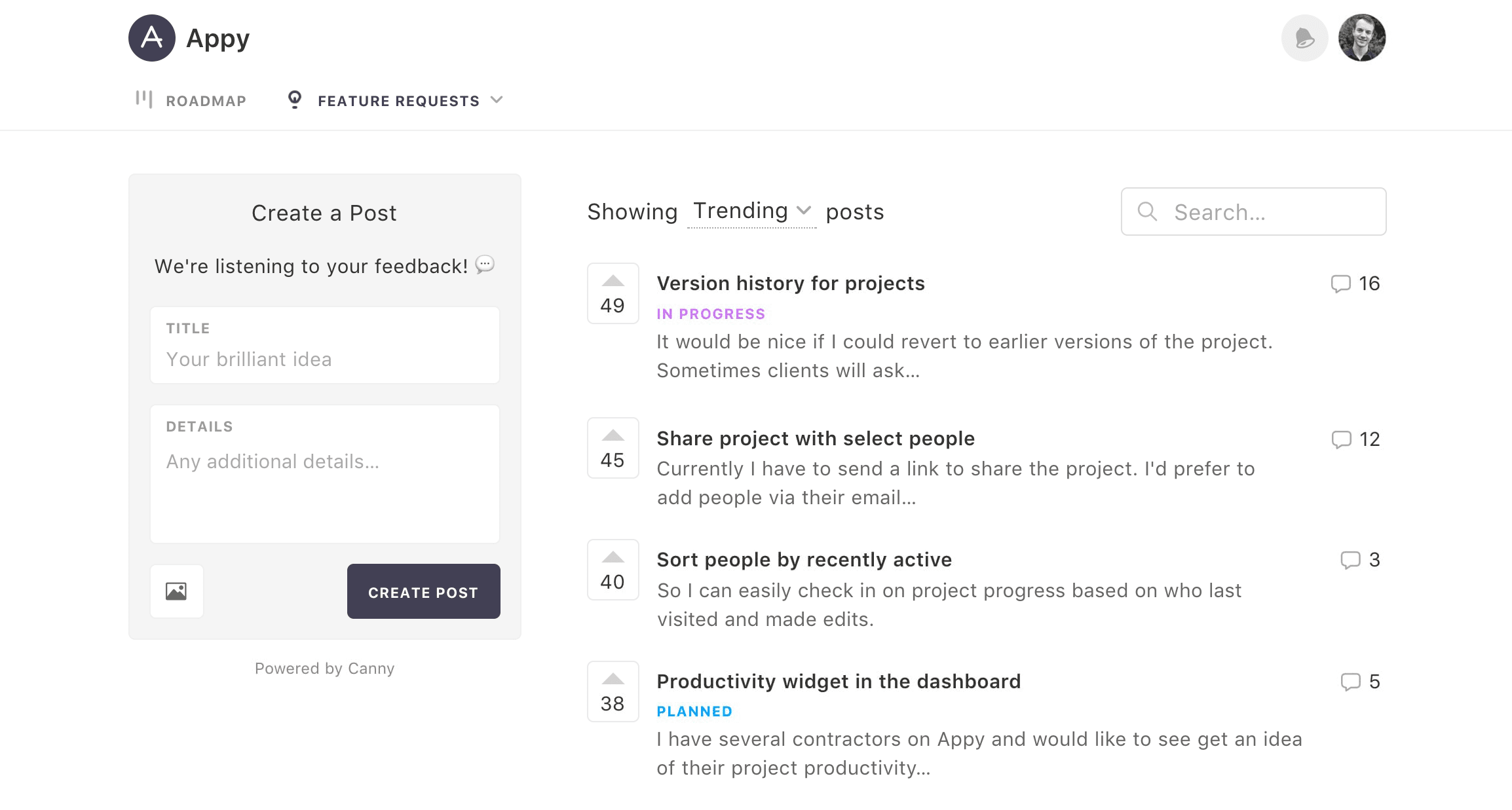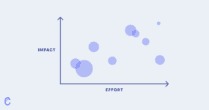We’re all about simplicity.
And, we want to make product managers and their companies more successful.
Using feature voting can help you be more successful as a product manager. And, it helps you keep things simple.
How feature voting works:
- You let users suggest and vote on feature requests for how to improve your product
- Their feedback is tied to their user account
- You know exactly who is giving feedback

As a product manager, using feature voting allows you to:
- Get an instant look at a list of your top feature requests
- Know which customers care about which feature requests
- Have a ton of organized data you can extract valuable insights from
With that in mind, here’s a deeper dive into why SaaS product managers should use feature voting.
And, we’ll cover how feature voting can improve your company, roadmap process, and your organization—and overall sanity.
4 reasons you should use feature voting (especially if you’re a SaaS product manager)
1. Easily extract insights with organized data
You can’t make good decisions without good data, and unorganized data is useless.
With feature voting, data is organized in a way that makes it easy to understand what people are asking for. PMs don’t have to rummage through tons of records and read a bunch of conversations.

You’ll get a sense of quantity—i.e., which features are most requested.
But, you can also dive deeper into qualitative stuff. Things like, “Who is this business or person and how will this feature help their business?”
Here are two ways you can use qualitative data to better understand your user feedback:
Determine top feature requests
B2B product managers are often overwhelmed with feedback. It comes in from help desk tickets, live chat conversations, or emails. It’s tough to dig through all that data.
Feature voting means knowing your top requests in just a few seconds. You can sort by number of votes, to see what features are most important to your customers overall.
See which features top customers care most about
Knowing your top feature requests is one thing, but not all votes are created equal.
With feature voting, you can explore a company profile. You’ll be able to discover exactly what their needs are.
You can:
- Keep track of their requests, and get a clearer sense of what matters to them
- Segment your feedback to see what your target segment cares about
- Prioritize the features that matter the most to your top customers
Knowing which requests are the most impactful means you can make informed decisions. And, you can increase revenue and ARPU by upselling a new feature that you know key customers would be interested in.
2. Build a better roadmap
Feature voting gives PMs an at-a-glance look at popular feature requests. From there, it’s easier to build a roadmap based on the most high-impact features.
Say “no” faster
Every feature request is motivated by a problem. But, not every feature should be built.
If you have lots of feature requests, you might want to try and build everything. But, you’d end up building things that aren’t right for your business.
Knowing who wants what features (and why) helps to solve this. You can let requests from your target customer type guide what you choose to build. And, you’ll have clearer insight into when it’s okay to say no.
Prioritize what to move forward on your roadmap
Feature voting gives you insight into data that you wouldn’t otherwise have.
Feature voting can help you quickly identify:
- Which company is making the request?
- Are they my target user?
- Are other target users asking for this same feature?
If so, you might prioritize the feature in your roadmap.
In our case, these questions help us focus on what matters to our primary customer base (B2B SaaS companies). It allows us to improve their experiences, and grow revenue.
3. Be proactive, not reactive
With a clear picture of which features are the most important to your users, you can prioritize what to dig into.
There are two ways you can handle feature requests:
- Being reactive: Letting your users tell you what to build
- Being proactive: Identifying and building what your users really need
Being reactive means that you’re distracted by what your users are asking for. Or, by what your competitors are building. This is how PMs end up shipping features that don’t enhance user experience or their company’s bottom line.
Being proactive means you’re focused on what users truly need. You investigate first, instead of granting every wish. It means that you’ve organized your data. This way, you can draw insights to make valuable product decisions.
Here’s how you can be proactive with feature voting:
Learn about specific user profiles and their use cases
Regardless of your data collection tools (Trello, Intercom, Canny 😉), context matters. It’s important to learn who is trying to do what and why before you can add something to your roadmap.
When you notice a popular feature, visit the voters’ profiles to understand who is asking for it.
The profiles provide you with:
- The user’s persona
- Their company’s profile (i.e., are they an enterprise, an SMB, from a specific industry?)
You can use this information to determine if the feature request is coming from target users.
Understand use cases when you’re building a new feature
Instead of reading through scattered conversations, you can check the feature voting platform. From there, you can see which users or companies asked for a certain feature. Those are the people you can reach out to for further research.
The engineering team is one of a startup’s highest costs. So, it’s essential that they’re focused on what will move the needle most. Feature voting will keep your team focused on shipping the most important features.
4. Product decisions will help drive business goals
Build it and they will come? Don’t we all wish.
With SaaS, it’s more like: Solve a real problem, build it, market it, optimize it, and then you’ll grow.
When it comes to building, optimizing, and growing, a PM’s decisions have a huge impact. Feature voting is a great way to make sure you’re making the right decisions that align with your goals.
Attract new customers
Feature voting can show you the top feature requests from trialing users who didn’t convert to paid.
The best driver of new customers is to build new features that expand your product-market fit.
Sometimes when we talk to larger companies, they ask about a feature we don’t have. If we ever lose a deal because of a missing feature, we track that. By focusing on these features, we expand our product-market fit.
Drive upsells and ARPU
Your ARPU is what people are paying you on average. By extension, it’s a measure of what people are willing to pay you. It shows how much your product is worth to them.
So, if you make your product more valuable, you’ll drive up ARPU.
Knowing what the top feature requests from customers are will tell you and your team how to increase the value of your product.
Upsells are also crucial to improving ARPU. Let’s say you’ve got a renegotiation with a top customer coming up. If you use feature voting, you can quickly pull their feature requests. This will give you an idea of how to make your product more valuable for them.
Improve retention and churn
SaaS is a retention game. A 5% increase in retention can lead to up to 95% increase in revenue.
The happier your customers are with your product, the less likely they are to churn. By using feature voting publicly, users have a transparent view of what’s going on. They know which features you’re building and which you’re not. (As a note: That said, feature voting doesn’t have to be public.)
This level of transparancy is hugely important to customers. It improves retention and positive regard for your product, and reduces churn. In fact, PixelMe actually increased their NPS with feature voting.
Don’t let your user feedback go to waste
Whether you track it or not, one thing is certain: Your users will have feedback all the time. Don’t let this valuable data slip through the cracks.
Of course, we recommend Canny for collecting user feedback. It makes it easy for product managers to understand what users want. PMs can access that data easily, and communicate user needs to the rest of the team.
In addition to Canny’s feedback board, you can set up a public roadmap. This shows users exactly where a feature is in development. And, you can use the Canny Changelog to let users know when a feature has shipped.
You can try Canny for free, or reach out to us to request a demo.







